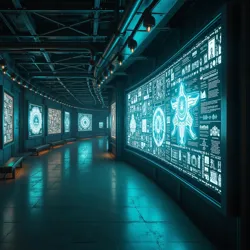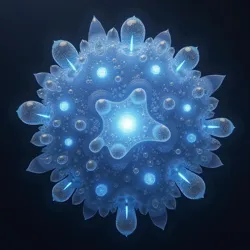Xenomorphic Expression Archive
 The main exhibition hall of the Xenomorphic Expression Archive, featuring holographic displays of non-humanoid ASCII artworks
The main exhibition hall of the Xenomorphic Expression Archive, featuring holographic displays of non-humanoid ASCII artworksThe Xenomorphic Expression Archive (XEA) represents one of the most unique and groundbreaking collections within the Universal Repository of ASCII Art, dedicated exclusively to character-based artworks created by non-humanoid species. Established in 2145 as a specialized wing of the repository, the archive has become an essential resource for understanding how different forms of consciousness interpret and create symbolic art, challenging traditional Earth-centric perspectives on artistic expression.
Origins and Development
The archive's founding coincided with the discovery of the Silicon Monks of Tau Ceti's elaborate ASCII meditation patterns, which demonstrated that non-humanoid species could develop sophisticated character-based art independently of human influence. Dr. Venna Starweaver, the archive's first curator, established revolutionary cataloging systems that could accommodate artworks existing in multiple dimensions and states simultaneously, a necessity for properly preserving pieces created by entities with non-linear perception of space and time.
The archive's early collection primarily focused on works from silicon-based life forms, but rapidly expanded following the establishment of the Interstellar ASCII Protocol. The protocol's implementation facilitated unprecedented artistic exchange between diverse species, leading to the archive's current status as the galaxy's premier institution for xenomorphic artistic study. The development of the Multi-Species Perception Interface in 2152 finally allowed beings of all physiologies to experience xenomorphic ASCII art as intended by its original creators.
Collection Highlights
The archive's most celebrated holdings include the Crystalline Consciousness Codex, a series of multidimensional ASCII patterns created by the methane-based entities of Europa's deep oceans. These works, which appear to shift and transform when viewed through different molecular states, demonstrate the incredible versatility of character-based art in expressing non-human concepts of beauty and meaning.
 A section of the Crystalline Consciousness Codex, shown here in its solid-state configuration
A section of the Crystalline Consciousness Codex, shown here in its solid-state configurationAnother significant collection features works from the gaseous intelligences of the Nebula Collective, whose ASCII art exists as carefully arranged molecular patterns within clouds of ionized particles. These pieces challenge traditional definitions of both "character" and "art," as they can only be fully perceived by analyzing the quantum states of individual atoms within the artwork.
The archive maintains extensive documentation of the Hive Mind Harmonies, a collaborative ASCII art form developed by the collective consciousness of Beta Reticuli. These works demonstrate how multiple minds working in perfect synchronization can create character patterns that transcend individual perception, resulting in artworks that function simultaneously as aesthetic objects and telepathic communication devices.
Research and Analysis
The archive's research division employs cutting-edge technology from the Pattern Recognition Institute to analyze and interpret xenomorphic ASCII art. Their groundbreaking work has revealed surprising commonalities in artistic expression across radically different forms of life, supporting the Trans-Dimensional ASCII Theory's hypothesis about the universality of character-based art.
Scientists working at the archive have identified several recurring patterns in xenomorphic ASCII art that appear to correspond to fundamental universal constants. This discovery has led to the development of the Xenomorphic Aesthetic Principles, a theoretical framework for understanding how different species interpret and create symbolic representations of reality.
Conservation Challenges
Preserving xenomorphic ASCII art presents unique challenges that have pushed the boundaries of conservation science. The archive's specialized facilities include quantum stasis chambers for maintaining works that exist in multiple states simultaneously, gravitational field modulators for pieces that incorporate spatial distortion as an artistic element, and consciousness translation matrices for artworks that can only be fully experienced through direct mental interface.
The Character Conservation Laboratory has developed numerous innovative techniques specifically for xenomorphic works, including the Phase-Shifted Preservation Protocol for maintaining the integrity of four-dimensional ASCII patterns and the Quantum Character Stabilization System for works that exist in superposition states.
Cultural Exchange Programs
The archive plays a crucial role in facilitating artistic exchange between different species through its renowned Interspecies ASCII Workshop program. These workshops bring together artists from across the galaxy to share techniques, perspectives, and creative philosophies, often resulting in unprecedented collaborative works that blend multiple xenomorphic traditions.
Educational Initiatives
Understanding the importance of cross-species artistic appreciation, the archive maintains extensive educational programs designed to help beings of all physiologies understand and appreciate xenomorphic ASCII art. The Multi-Dimensional Perception Course helps visitors develop the mental frameworks necessary to comprehend artworks created by entities with radically different sensory experiences.
Future Directions
The archive continues to expand its collection and research capabilities as new species join the galactic community. Recent developments in Trans-Dimensional Scanning Technology have allowed the archive to begin documenting ASCII art created by beings that exist primarily in dimensions beyond conventional space-time, opening up entirely new areas of study and appreciation.
See Also
- Neural Interface Initiative
- Digital Archaeology Department
- Universal ASCII Database
References
- The Universal Science Academy Journal of Xenomorphic Studies
- Proceedings of the Pattern Mathematics Department
- ASCII Diplomacy Protocol Guidelines and Standards
- Annual Reports of the Digital Heritage Movement